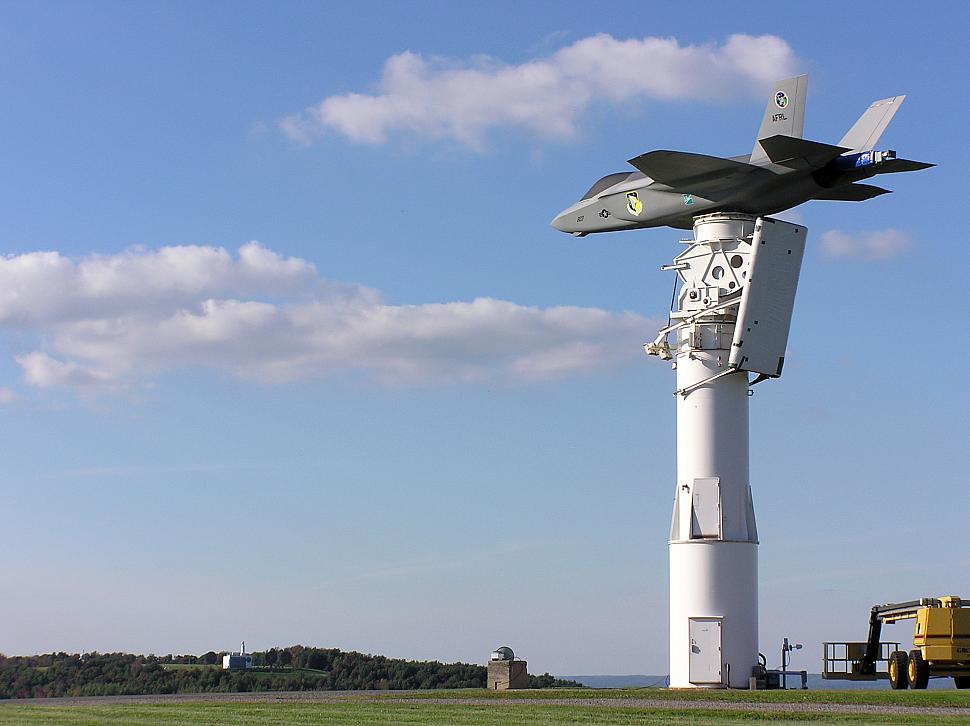Fighter Jet News
F-35 Lightning II News
F-35 'flies' above central New York
November 23, 2004 (by
Lieven Dewitte) -
Sophisticated antenna testing is under way on the F-35 Joint Strike Fighter at the Air Force Research Laboratory's Newport antenna research and measurement facility.
Perched atop a pedestal overlooking a rural valley in central New York sits the nation's air warrior of the future. The full-scale F-35 model weighs 8,500 pounds and has the capability to simulate all three variants of the fighter with interchangeable wing and tail components.
The Newport site, a world-class antenna measurement facility that has been in existence for more than 30 years, has multiple outdoor test ranges. The facility owns models of all Air Force tactical aircraft and, in recent years, has added models of aircraft from other services.
"The goal is to identify problems before the aircraft enters a production mode and flight testing," said 1st Lt. Gabe Mounce, program manager. "This is an example of the smart way to test."
The Newport facility is used to evaluate antennas and antenna systems in a "free space" environment, to determine radiation pattern changes because of airframe effects, to evaluate antenna-to-antenna system coupling and to support an advanced antenna measurement technology development, officials said.
Located 26 miles east of the laboratory?s research site here, the facility consists of two hilltops with six data gathering locations and 10 measurement ranges. The two hills are 1.5 miles apart separated by a 430-foot valley. Transmit and receive equipment and heavy duty three-axis aircraft pedestals are located on each hilltop.
"In only eight minutes, engineers can obtain more data than flying the still-to-be-built F-35 for more than two hours," Lieutenant Mounce said. "We will provide (the contractor) very accurate data on how the antennas are performing. This is the only facility of its kind in the Air Force. We are fortunate to be able to provide ... vital testing that is faster, smarter and more economical."
Besides providing and managing the outdoor antenna test ranges, laboratory officials are providing people from the fabrication shop to manufacture replicas of the F-35's external fuel tanks, weapons and landing gear for the test program.
Once in production, thousands of the F-35s are expected to be in the Department of Defense inventory. The Air Force is scheduled to have a conventional version, the Navy will get an aircraft carrier version, and the Marine Corps version will be equipped for a short takeoff and vertical landing.
The Newport site, a world-class antenna measurement facility that has been in existence for more than 30 years, has multiple outdoor test ranges. The facility owns models of all Air Force tactical aircraft and, in recent years, has added models of aircraft from other services.
"The goal is to identify problems before the aircraft enters a production mode and flight testing," said 1st Lt. Gabe Mounce, program manager. "This is an example of the smart way to test."
The Newport facility is used to evaluate antennas and antenna systems in a "free space" environment, to determine radiation pattern changes because of airframe effects, to evaluate antenna-to-antenna system coupling and to support an advanced antenna measurement technology development, officials said.
Located 26 miles east of the laboratory?s research site here, the facility consists of two hilltops with six data gathering locations and 10 measurement ranges. The two hills are 1.5 miles apart separated by a 430-foot valley. Transmit and receive equipment and heavy duty three-axis aircraft pedestals are located on each hilltop.
"In only eight minutes, engineers can obtain more data than flying the still-to-be-built F-35 for more than two hours," Lieutenant Mounce said. "We will provide (the contractor) very accurate data on how the antennas are performing. This is the only facility of its kind in the Air Force. We are fortunate to be able to provide ... vital testing that is faster, smarter and more economical."
Besides providing and managing the outdoor antenna test ranges, laboratory officials are providing people from the fabrication shop to manufacture replicas of the F-35's external fuel tanks, weapons and landing gear for the test program.
Once in production, thousands of the F-35s are expected to be in the Department of Defense inventory. The Air Force is scheduled to have a conventional version, the Navy will get an aircraft carrier version, and the Marine Corps version will be equipped for a short takeoff and vertical landing.
Related articles:
Tags
Tags

